Aerial yoga is on the rise, literally, in the yoga world. There are many reasons to try it out and embrace it as an up and coming style of yoga.
Also known as air yoga, swing yoga, flying yoga, and by the brand name AntiGravity Yoga, aerial yoga combines the alignment principles of Iyengar with the acrobatics of the circus-style silk hammock.
If you’re feeling bored or stagnant in your yoga routine, it can add a good amount of serious fun to your practice while the hammock provides a new prop to enhance your mental and physical awareness.
If you have any reservations about aerial yoga, here are five reasons to take flight with aerial yoga and soar to new heights in your practice!
1. Advance Your Asana
The aerial yoga hammock is like a time machine that helps you develop your asana practice quicker over a shorter period of time.
If you happen to take a break for some time from your practice, due to holiday or even injury, you can practice on the yoga hammock and regain your strength and flexibility much quicker to get back to where you were previously and advance faster.
This is useful for postures such as hanumanasana (the splits), eka pada rajakapotasana (one-legged king pigeon pose), and adho mukha vrksasana (handstand).
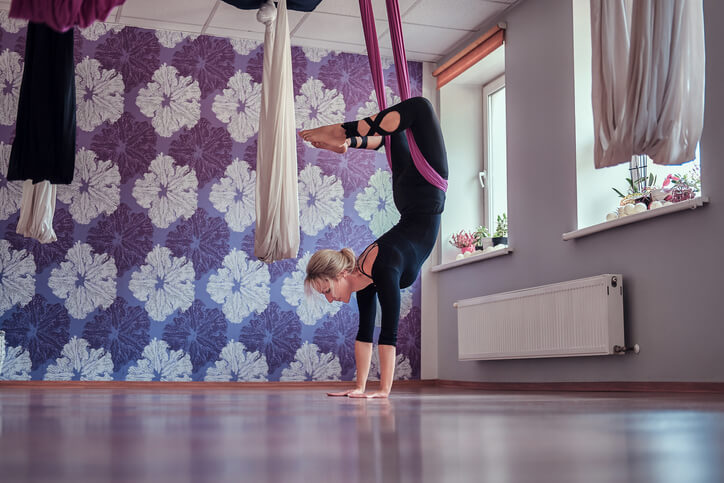
Not only can you find more precision and strength in your physical practice, but you can also stretch deeper with the hammock as a prop.
It works by supporting specific body parts during postures so that the emphasis of the stretch can sink deeper with the help of gravity, a free resource all around us!
Sometimes that gravity may cause us to fall in regular practice and often the floor stops us from getting any deeper in a pose. When you are able to stretch safely and deeper into a particular posture, it creates space within the joint so that you see an improvement in your flexibility when you try the same pose on your yoga mat.
Read: Take to the Air: An Introduction to Aerial Yoga
2. Go Upside-Down Safely
One of the interesting aspects of yoga practice and in particular, Aerial yoga, is the inversions. It is an important part of the physical practice and sequencing (no matter what poses you practice).
Some people have great fear when it comes time to practice them and for others, they feel excitement.
However, it is best to be cautious with particular inversions such as salamba sarvangasana (shoulderstand) and sirsasana (headstand) as they can place a great deal of pressure on the neck.
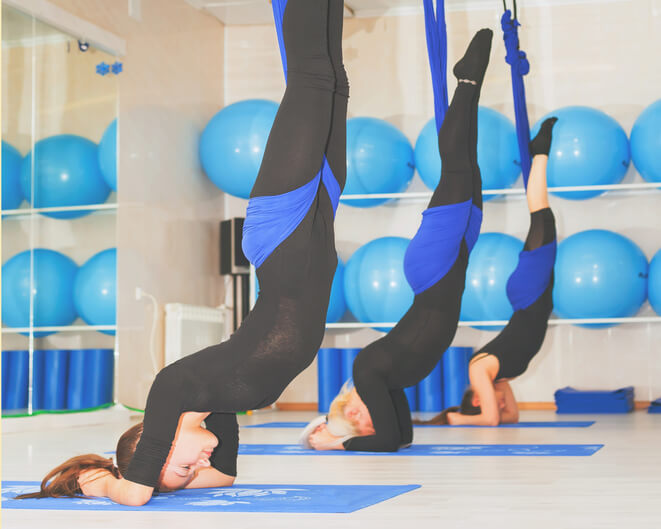
With the use of the aerial hammock, you can sit in the hammock like a swing and make a skirt as you go upside-down. This skirt wrap decreases any pressures on the lower back in case of lumbar disorders and gives the full benefits of inversions to even those who are afraid to go upside-down.
One of the main benefits of aerial yoga inversions is that they decompress the spine. It is a great way to work through fears and allow the hammock to hold you in a way to just surrender.
Read: 10 Benefits of Inversions
3. Find New Strength
A ground-based asana practice can be incredibly strengthening, especially if you practice Ashtanga or vinyasa. The many downward dogs and chaturangas will develop the arm and shoulder muscles. However, what’s missing is pulling strength, such as in doing a pull-up.
This is nearly impossible to develop in a mat yoga practice. Here is where aerial yoga comes in!
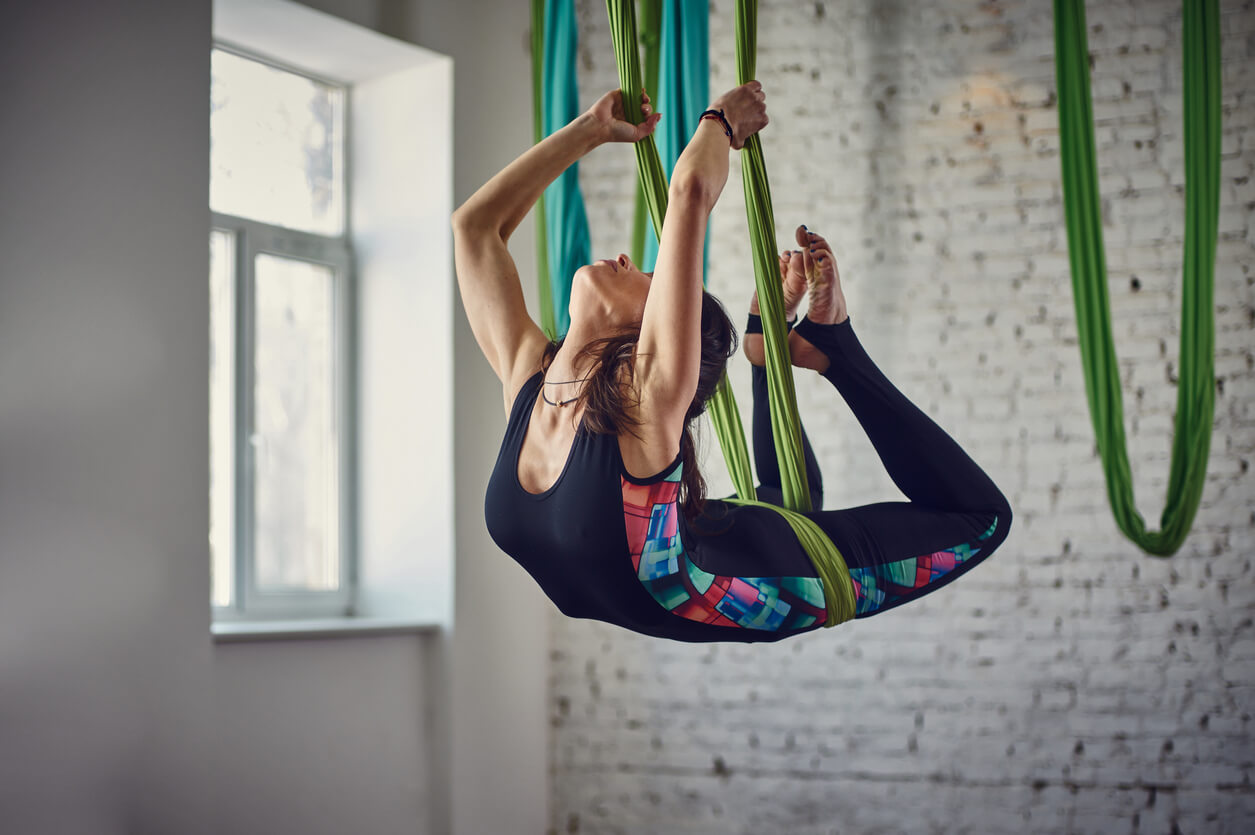
Aerial yoga allows you to practice fun variations on pull-ups in various ways using the soft fabric. Learning how to lift yourself up and perform flips in a way that is close to the ground makes this strength-building skill more accessible than its acrobatic cousin, the circus-style silks.
Sometimes the body reaches a plateau point with the same practice or exercise routine, so It’s important to switch things up. Aerial yoga is a great compliment to a mat practice or other workout regimen.
Read: The Power of Chaturanga
4. Improve Your Alignment
It is an unlikely possibility that anyone who practices yoga asana has never fallen out of a posture. There are many difficult postures in traditional hatha yoga, whether its balancing on one leg, two, or even on your hands.
Many times, it is a combination of misalignment and not breathing properly that may cause you to fall out or continue to practice incorrect alignment over time. If you continue to practice an incorrect alignment for your body, it will hinder the depth at which you can deepen the pose and may stress the joints which lead to injury in a sustained practice.
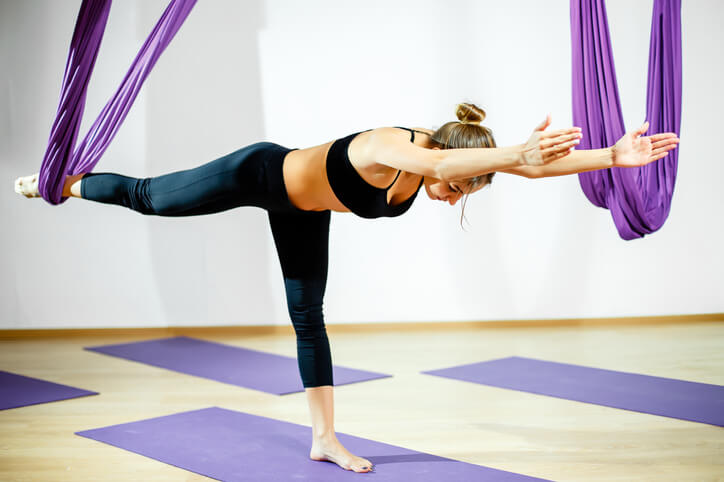
With the support of the aerial yoga hammock, you can give some of your body weight to this prop in order to balance more effectively.
One example is utthita hasta padangusthasana, also know as standing hand-to-big toe pose. Instead of holding the extended leg up by your own hands you can set the ankle in the aerial hammock loop. This allows you to find the alignment of your hips properly while breathing deeper and slower.
Read: 7 Simple Principles to Fix Many, if not Most, Common Asana Mistakes
5. Embrace Your Inner Monkey
Monkeys are the ultimate acrobats and representation of joy as they swing high up in the trees. Luckily, you don’t have to climb a tree to experience the sensation of flight.
As we get older, we often get attached to certain aspects of our lives, stress builds up, and we forget that life can be fun, too.
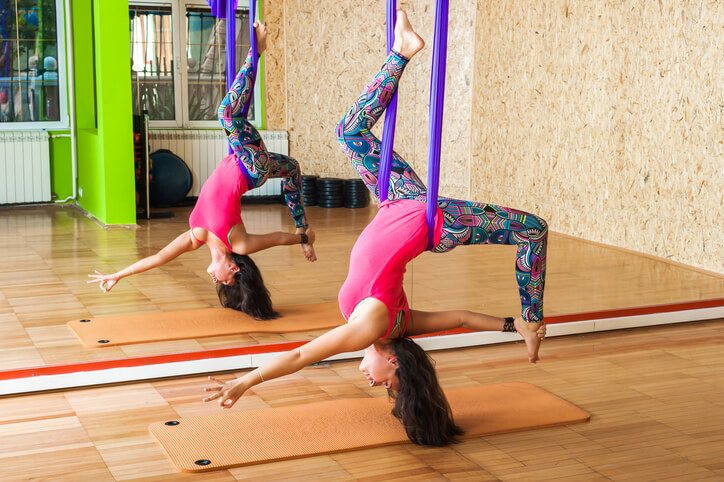
Read: Creating Freedom Through Playfulness and Creativity
Our jobs or conditioning by society may seem to zap the joy out of us. Aerial yoga can infuse a sense of playfulness back into your life when you feel like you need a little pick me up.
Next time you see Aerial yoga on a class schedule at your local studio, you may just want to swing in there and see how it can help you!
During These Times of Stress and Uncertainty Your Doshas May Be Unbalanced.
To help you bring attention to your doshas and to identify what your predominant dosha is, we created the following quiz.
Try not to stress over every question, but simply answer based off your intuition. After all, you know yourself better than anyone else.